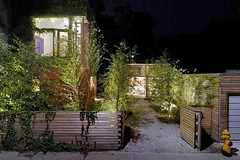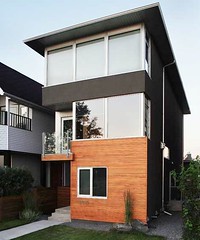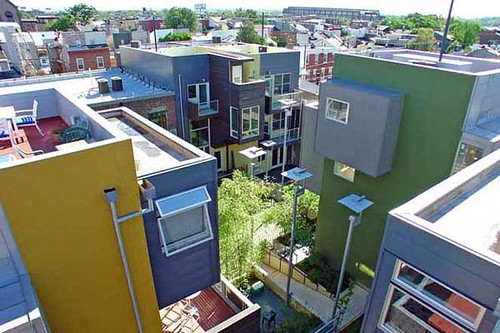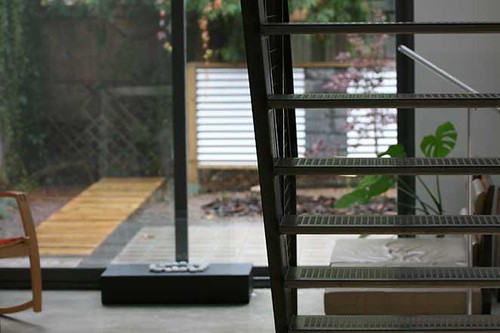10 steps to a "slow home" for more sustainable living

Posted January 11, 2011 at 1:28PM
The housing complex in Philadelphia pictured above is described by its architects as "an experiment in and a critique of sustainable forms of urban dwelling. This former industrial site has been re-contextualized as a residential garden community . . . [that] intentionally explores the necessary relationships between density, intimacy and privacy in any urban community." With the rather unheroic name Rag Flats, the complex is designed by a collaboration among three firms: housebrand, Minus Sudios, and Cover.
Rag Flats is one of quite a few designs included in a gallery on the web site of an endeavor known as the Slow Home Studio. Founded by principals John Brown and Matthew North of the architectural firm housebrand of Calgary, Alberta, and borrowing from the vocabulary of the slow food movement, the studio strives for a more “considered, calm and intuitive” approach to residential design.
While the name may sound a bit like new-age marketing, the slow home concept is laudably based on a philosophy of using good urban site selection and well-considered design principles to create smaller homes that will be both environmentally sustainable and literally so, in the sense of being built to endure. The practice also includes remodels of existing, appropriately sized older homes that need updating. North was interviewed by The Calgary Herald:
"I think the boom of the big-house era is coming to an end. So those houses will be less desirable and valuable as time goes on," North says . . . Expect a shift to smaller, more energy-efficient homes, North says, and a move away from homes on the fringes of cities. A decade ago, a 5,000-sq.-ft. home sounded like a dream to some. These days, that much square footage "sounds like a noose around your neck. There's uncertainty about the energy cost to heat your house." People are considering future energy costs, looking to minimize their exposure to outside sources of heating and electricity.
Addressing the issue of location, Brown told The Next American City (for an article written by Karl Magi) that the slow home principle of “living lightly” leads to redeveloping the inner city, since location is essentially a design choice that can simplify life:
“People walk around saying they don’t have enough time in their days and they think it has to do with external stresses. They don’t realize the choice that they made to live an hour away from where they work means that they spend two hours every day commuting.”
North and Brown have enlisted like-minded architects in other cities (see the firms featured in their gallery) to join their cause.
The Slow Home Studio site highlights ten basic “guidelines for a home that is simple to live in and light on the environment”:
- LOCATION: A Slow Home is located in a walkable neighborhood that minimizes your use of a car.
- ORIENTATION: A Slow Home is correctly oriented to the sun and properly related to its surroundings.
 ORGANIZATION: A Slow Home is modestly sized, and has a good flow between spaces with a strong connection to the outdoors
ORGANIZATION: A Slow Home is modestly sized, and has a good flow between spaces with a strong connection to the outdoors- ENTRY: The front and back entries in a Slow Home are spaces, not just doors.
- LIVING: All indoor and outdoor living spaces in a Slow Home have good daylight and are easy to furnish.
- KITCHEN: A Slow Home has a compact kitchen with an efficient layout, good work surfaces, and sufficient storage.
- DINING: A Slow Home has a well-defined dining area that properly fits a table that is suitable for daily use.
- BEDROOMS: All bedrooms in a Slow Home have good daylight, sufficient storage, and can logically fit a bed.
- BATHROOMS: A Slow Home has an appropriate number of well organized and modestly sized bathrooms.
- SERVICES: The service spaces in a Slow Home are unobtrusive and highly functional.
 (These principles have something in common with those underlying the “not so big houses” popularized by Sarah Susanka’s series of books. But in my opinion they improve on the concept. One of the few complaints I’ve had about Susanka’s designs and writings is that location and neighborhood walkability are pretty much ignored; the design principles, though sound, are confined to the lots and buildings.)
(These principles have something in common with those underlying the “not so big houses” popularized by Sarah Susanka’s series of books. But in my opinion they improve on the concept. One of the few complaints I’ve had about Susanka’s designs and writings is that location and neighborhood walkability are pretty much ignored; the design principles, though sound, are confined to the lots and buildings.)
For me, it’s the first three of the ten slow home guidelines that really distinguish sustainably located and designed homes from the rest, since in the last few decades so many houses have been built in unwalkable subdivisions, sited without regard to solar orientation, and sized far from modestly. The other principles are also important to good design, of course, but they are somewhat more frequently acknowledged.
When these steps are followed as conscious choices, designers and their clients are forging a more sustainable path, regardless of how the homes are labeled. If "slow homes" is a marketing phrase, more power to them: I'm hoping it's a successful one.
Learn more about slow homes here.
Move your cursor over the images for credit information.


